Braided Clutch Hose - Anyone Using One?
Discussion
phillpot said:
That may be a token side effect but surely the main purpose of the coil is to reduce the possibility of a fracture from movement or vibration.
The fluid near the manifold only "pops" down there for seconds when the clutch is operated!
I’m aware of that Phil The fluid near the manifold only "pops" down there for seconds when the clutch is operated!

It does increase the volume and cooling effect though.
Will a rubber hose give way before a metal pipe.
Will a rubber hose bulge and give you a loss of pressure if extreme heat is involved.
Thing is we live in a mild climate, nothing wrong with braided hoses

ChimpOnGas said:
Sardonicus said:
A braided hose is PTFE pipe (same as oil capillary pipe on old school Fords etc) wrapped in a stainless steel braid
Fair correction Simon, but PTFE is still a good insulator isn't it.You don't get many copper over gloves, and PTFE saucepan bottoms never really caught on

 just what I know and a bit of silicone thermal sleeve like on 02 sensor wiring should sort any heat soak issues
just what I know and a bit of silicone thermal sleeve like on 02 sensor wiring should sort any heat soak issues lancepar said:
Glad I read this as I'm thinking of going flexy because I've yet to sort out the refitting of all my hydraulics at the alloy tunnel union or to wherever the PO was going to connect them.
With regards the clutch the PO has replaced the metal pipe including a nice curly section but the pipe just ends up by the rocker cover without a fitting or flared end. So as I don't have a flaring tool going flexy would be an easy option.
I can however borrow a tool if I need one as the PO has modified the brake lines as well.
Any idea of the end fittings, length of pipe and where to get one made or bought.

Not sure if this helps at all. I'm probably going to stick to the existing copper as I dont want to waste money on parts just guessing.
https://www.pistonheads.com/gassing/topic.asp?h=0&...
With regards the clutch the PO has replaced the metal pipe including a nice curly section but the pipe just ends up by the rocker cover without a fitting or flared end. So as I don't have a flaring tool going flexy would be an easy option.
I can however borrow a tool if I need one as the PO has modified the brake lines as well.
Any idea of the end fittings, length of pipe and where to get one made or bought.

Not sure if this helps at all. I'm probably going to stick to the existing copper as I dont want to waste money on parts just guessing.
https://www.pistonheads.com/gassing/topic.asp?h=0&...
Classic Chim said:
There is a lot of heat travelling past this pipe and in standing traffic made much worse. The standard pipe will cool quicker when air flow does increase,still the best long term solution I believe.
Since a new clutch was fitted including new fork arm I have a very light clutch, the only time I notice it marginally firmer is after prolonged periods in heavy slow moving traffic so there’s deffo something in the heat that effects the hydraulic efficiency.
Would a braided pipe not be a heat sink area and harder to cool than a bare pipe?
It’s going to get hot in that area that’s for sure.
I like the old school winding of the brass pipe that adds area and cooling efficiency.
I’ve used a braided clutch hose for many years including a few long & hot trips to SPA and Le Mans with no problems.Since a new clutch was fitted including new fork arm I have a very light clutch, the only time I notice it marginally firmer is after prolonged periods in heavy slow moving traffic so there’s deffo something in the heat that effects the hydraulic efficiency.
Would a braided pipe not be a heat sink area and harder to cool than a bare pipe?
It’s going to get hot in that area that’s for sure.
I like the old school winding of the brass pipe that adds area and cooling efficiency.
I bought mine from Clever Trevor many moons ago so maybe worth calling www.racetechdirect.co.uk as Keith from Clever Trevor now works their or you could also try www.thinkauto.com
If braided hoses are good enough for hot brakes they are more than adequate for the clutch.
I replaced the copper hose with a braided one when my slave cylinder went pop last year. I've had no issues.
I got it from Earl's in Silverstone. It's saved on their system as "TVR Clutch flexi hose" under document number 175246 so you should just be able to quote that and they'll know what to make if anyone wants one. The length is perfect for my set up, I'd be tempted to ask for another inch or two on the length, as we know not all TVR's are built the same!
You can even get it in a wide variety of colours should you want to be a bit more garish
It was £42 when I got it.
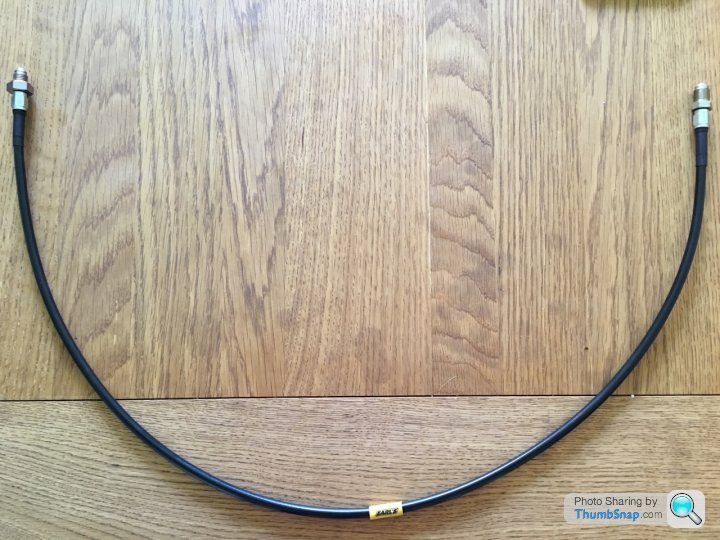
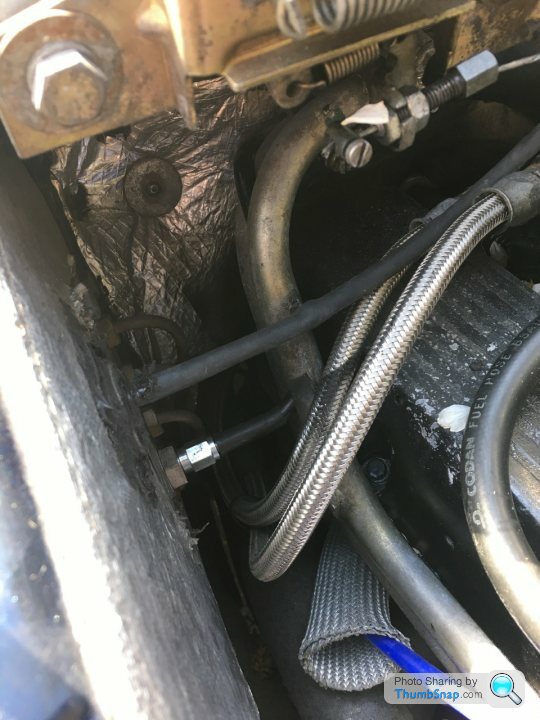
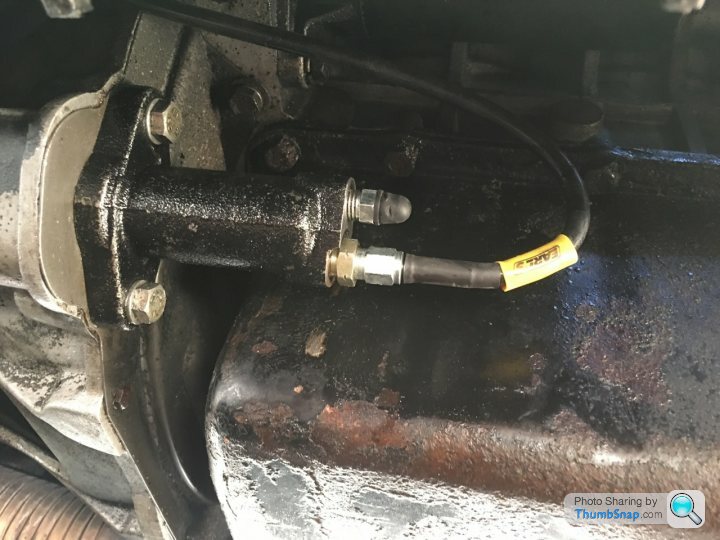
I got it from Earl's in Silverstone. It's saved on their system as "TVR Clutch flexi hose" under document number 175246 so you should just be able to quote that and they'll know what to make if anyone wants one. The length is perfect for my set up, I'd be tempted to ask for another inch or two on the length, as we know not all TVR's are built the same!
You can even get it in a wide variety of colours should you want to be a bit more garish

It was £42 when I got it.



Brilliant Gareth, that's super helpful for those considering going to a flexi, I've been running mine for a year or so now and it works perfectly 
But I have to say the clutch hydraulic system on our cars does have one key weakness no hose could ever hope to solve, the issue being air in the system...... which in my experience is a perennial problem all Chimaeras suffer with annoying regularity, a problem that directly relates to the fact TVR chose a Girling master cylinder (common to many British cars from the 1960's & 70's), this type of master cylinder was specifically designed to be mounted in a horizontal position.
The Girling unit is a Non-residual Pressure Master Cylinder, this type of master cylinder contains the pressure chamber and an end fluid reservoir, the piston operates in the pressure chamber whereas the reservoir permits additional fluid to enter into or return from the system to maintain a constant volume during temperature changes and any seepage of fluid in the system.
Reservoir volume is extremely important, even when mounted correctly a Girling master cylinder reservoir capacity is minuscule, holding a header of just 45ml of fluid. Actually only 35ml sits above the port so even mounted horizontally there's very little safety margin, make no mistake if that little port you can see at the bottom of the reservoir ever gets revealed, and the cylinder isn't already completely at the end of it's stroke, the system will no longer draw fluid..... it'll draw air instead!
Air being the enemy of any hydraulic system, because unlike a fluid..... air is compressible!
Study the effect on reservoir volume when you fail to correctly mount the cylinder horizontally as the Girling designers intended, incorrectly mount it at an angle as TVR did and your already tiny 35ml header of fluid in the reservoir suddenly becomes just 22ml because you simply can't fill it with any more fluid before it spills over the lowest edge of the reservoir top
Now consider what happens when you operate your clutch, as you press down on the pedal the fluid inside your master cylinder is forced under huge pressure into the slave cylinder which extends to act on your clutch release arm. Very quickly the fluid in your master cylinder is all used up as it fills the extending slave cylinder, so the master cylinder will always need a supply of additional fluid that is greater than the volume of the master cylinder itself, this is why we need a reservoir.
EXAMPLE 1 (Correct Horizontal Installation)
The figures used in my two examples are just that, examples. But as we can see example one tells us the volume of reserve fluid above port when both cylinders are fully stroked in a horizontally mounted master cylinder will be a safe 18ml, however in example two where the master cylinder is mounted at an angle we will only have a tiny 3ml of fluid above the port when both cylinders are fully stroked. Now consider what would happen if you've leaked just 4ml of fluid over time, which is super common because lets face it Girling master & slave cylinders aren't the best
Suddenly the calculation looks like this: 5 + 20 - 4ml leakage - 22 = -1ml reserve fluid above port
If your reserve fluid falls below the port (-1ml) the system will be drawing a tiny amount of air every time you operate the clutch, over an extended period all those tiny pockets of air all line up to create one larger and very easily compressible bubble. The outcome being even when you push your clutch pedal right to the floor the slave will never be quite 100% extended, so the clutch will not actually be fully disengaged. Like this the driven plate will be very slightly dragging making gear selection feel baulky, if the problem is slight the resistance may not be felt when changing gear on the move but you sure as hell will have trouble popping the car into first when you're sat stationary at the lights and preparing to pull away.
Actually I've discovered on my Chimaera I can get away with a bit of air in the system, but obviously like this the clutch bite point gets closer to the floor but you can still get all gears, I suspect if you analysed the clutch hydraulics of 100 Chimaeras 95 of them would have some air present. But the truth is they are right on the edge of clutch drag, all you need is a bit more air or something else to change and you'll be in trouble. That something else comes in the form of heat, while the fliud can get hot and the slave cylinder can get overheated from heat transfer from the engine block this is only part of the issue, what also happens is the pressure plate becomes heat soaked making it expand.
It's one of those situations where a single issue on its own is not enough to cause a problem, but an accumulation of multiple issues can be enough to push what is already a compromised and marginal setup outside of operational tolerance, the straw that breaks the camel's back is usually heat because heat rises with use, and after a number of hours of driving the transmission tunnel and all the components in that area can become very heat soaked on a Chimaera.
At this point things can add up to a critical mass situation that normally manifests itself as a baulky gear box in stop start driving on a hot day after the car has been driven for over an hour or so, this on a Chimaera that had lovey gear selection when started from cold and for the first hour of driving.
A small amount of air + a hot slave cylinder + heated clutch fluid + a hot pressure plate = poor gear selection when stationary
Keep in mind if you've checked your clutch fluid recently and found it was even a few ml off brimmed... you've almost certainly got some air in your system. Topping the reservoir up to the brim again does not get rid of that air, it only stops more air being introduced.
Only bleeding the system will resolve the issue, but bleeding a Chimaera clutch system can be problematic in itself, clearly you need to replenish the reservoir 'up top' at the same rate as you're releasing fluid at the slave 'down below' when you open the bleed nipple. Because with the master cylinder fitted at an angle there's so little reserve fluid above port it's super easy you reveal the port and introduce air if you're not topping up quickly enough.
It is therefore absolutely imperative to have an assistant up top filling the reservoir when bleeding a Chimaera's clutch hydraulics.
Actually the small capacity offered by an integral reservoir Girling master cylinder is a well know issue outside of TVR circles, even on a car where the master cylinder is correctly horizontally mounted because the 35ml capacity is right on the very limit of being adequate, so mounting the master cylinder at an angle as TVR did was asking for trouble. People running Girling master cylinders on a competition car will often use one that has a remote reservoir, this can then be made as big as you like and as long as it's mounted higher than the master cylinder it will work extremely well and solve the problem.
For those like us who struggle with space and cannot find a location above the master cylinder for a larger remote reservoir, a reservoir extension was developed, this simply screws on where your reservoir cap goes and hey presto you've instantly doubled your fluid capacity
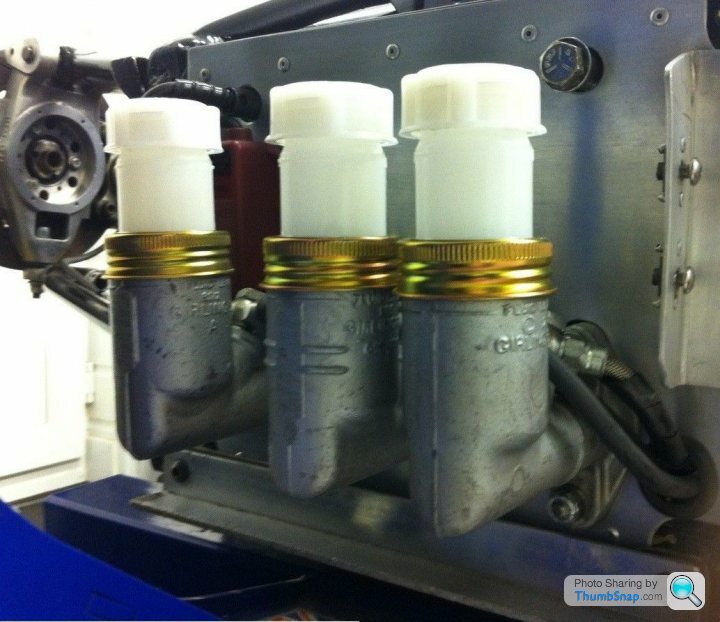
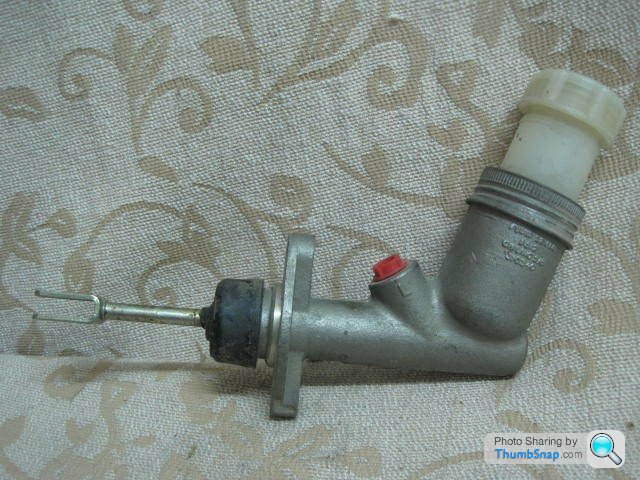
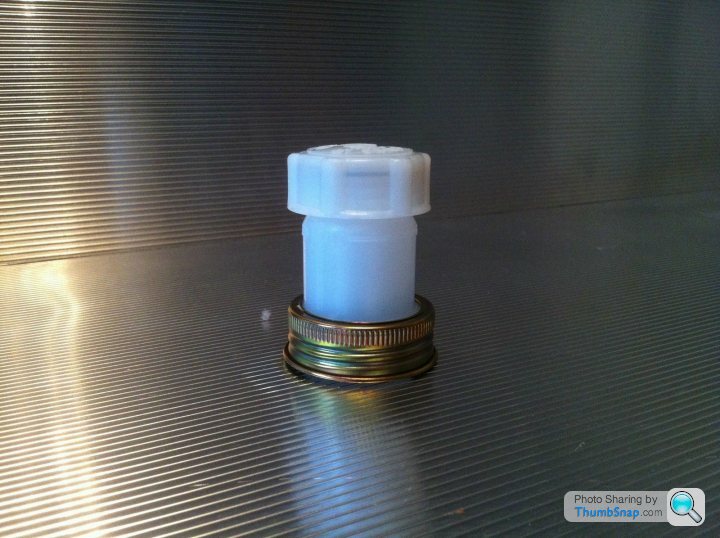
At £26.00 a pop these reservoir extenders are expensive for what they are, and then you've got the added issue of modifying your TVR fiberglass clutch master cylinder cover, but I still think it would be a great addition to any Chimaera for the reasons I've covered above. To that end I've just bought one, I'll try to fit it this weekend as my cluch hydraulics need bleeding and I'll let you all now how I get on.
For anyone interested in all this, you can buy this reservoir extender here:
https://www.ebay.co.uk/itm/Girling-Master-Cylinder...
Dave.

But I have to say the clutch hydraulic system on our cars does have one key weakness no hose could ever hope to solve, the issue being air in the system...... which in my experience is a perennial problem all Chimaeras suffer with annoying regularity, a problem that directly relates to the fact TVR chose a Girling master cylinder (common to many British cars from the 1960's & 70's), this type of master cylinder was specifically designed to be mounted in a horizontal position.
The Girling unit is a Non-residual Pressure Master Cylinder, this type of master cylinder contains the pressure chamber and an end fluid reservoir, the piston operates in the pressure chamber whereas the reservoir permits additional fluid to enter into or return from the system to maintain a constant volume during temperature changes and any seepage of fluid in the system.
Reservoir volume is extremely important, even when mounted correctly a Girling master cylinder reservoir capacity is minuscule, holding a header of just 45ml of fluid. Actually only 35ml sits above the port so even mounted horizontally there's very little safety margin, make no mistake if that little port you can see at the bottom of the reservoir ever gets revealed, and the cylinder isn't already completely at the end of it's stroke, the system will no longer draw fluid..... it'll draw air instead!
Air being the enemy of any hydraulic system, because unlike a fluid..... air is compressible!
Study the effect on reservoir volume when you fail to correctly mount the cylinder horizontally as the Girling designers intended, incorrectly mount it at an angle as TVR did and your already tiny 35ml header of fluid in the reservoir suddenly becomes just 22ml because you simply can't fill it with any more fluid before it spills over the lowest edge of the reservoir top

Now consider what happens when you operate your clutch, as you press down on the pedal the fluid inside your master cylinder is forced under huge pressure into the slave cylinder which extends to act on your clutch release arm. Very quickly the fluid in your master cylinder is all used up as it fills the extending slave cylinder, so the master cylinder will always need a supply of additional fluid that is greater than the volume of the master cylinder itself, this is why we need a reservoir.
EXAMPLE 1 (Correct Horizontal Installation)
- Volume of fluid held within the master cylinder = 5ml
- Volume of additional fluid held within the mater cylinder reservoir when mounted horizontally = 35ml
- Volume of fluid occupied by the fully extended slave cylinder = 22ml
- So with the Girling master cylinder mounted horizontally the calculation looks like this: 5 + 35 - 22 = 18ml reserve fluid above port
- Volume of fluid held within the master cylinder = 5ml (this does not change)
- Volume of additional fluid held within the mater cylinder reservoir when mounted at an angle = 20ml
- Volume of fluid occupied by the fully extended slave cylinder = 28ml (this does not change)
- So with the Girling master cylinder mounted at an angle the calculation looks like this: 5 + 20 - 22 = 3ml reserve fluid above port
The figures used in my two examples are just that, examples. But as we can see example one tells us the volume of reserve fluid above port when both cylinders are fully stroked in a horizontally mounted master cylinder will be a safe 18ml, however in example two where the master cylinder is mounted at an angle we will only have a tiny 3ml of fluid above the port when both cylinders are fully stroked. Now consider what would happen if you've leaked just 4ml of fluid over time, which is super common because lets face it Girling master & slave cylinders aren't the best

Suddenly the calculation looks like this: 5 + 20 - 4ml leakage - 22 = -1ml reserve fluid above port
If your reserve fluid falls below the port (-1ml) the system will be drawing a tiny amount of air every time you operate the clutch, over an extended period all those tiny pockets of air all line up to create one larger and very easily compressible bubble. The outcome being even when you push your clutch pedal right to the floor the slave will never be quite 100% extended, so the clutch will not actually be fully disengaged. Like this the driven plate will be very slightly dragging making gear selection feel baulky, if the problem is slight the resistance may not be felt when changing gear on the move but you sure as hell will have trouble popping the car into first when you're sat stationary at the lights and preparing to pull away.
Actually I've discovered on my Chimaera I can get away with a bit of air in the system, but obviously like this the clutch bite point gets closer to the floor but you can still get all gears, I suspect if you analysed the clutch hydraulics of 100 Chimaeras 95 of them would have some air present. But the truth is they are right on the edge of clutch drag, all you need is a bit more air or something else to change and you'll be in trouble. That something else comes in the form of heat, while the fliud can get hot and the slave cylinder can get overheated from heat transfer from the engine block this is only part of the issue, what also happens is the pressure plate becomes heat soaked making it expand.
It's one of those situations where a single issue on its own is not enough to cause a problem, but an accumulation of multiple issues can be enough to push what is already a compromised and marginal setup outside of operational tolerance, the straw that breaks the camel's back is usually heat because heat rises with use, and after a number of hours of driving the transmission tunnel and all the components in that area can become very heat soaked on a Chimaera.
At this point things can add up to a critical mass situation that normally manifests itself as a baulky gear box in stop start driving on a hot day after the car has been driven for over an hour or so, this on a Chimaera that had lovey gear selection when started from cold and for the first hour of driving.
A small amount of air + a hot slave cylinder + heated clutch fluid + a hot pressure plate = poor gear selection when stationary
Keep in mind if you've checked your clutch fluid recently and found it was even a few ml off brimmed... you've almost certainly got some air in your system. Topping the reservoir up to the brim again does not get rid of that air, it only stops more air being introduced.
Only bleeding the system will resolve the issue, but bleeding a Chimaera clutch system can be problematic in itself, clearly you need to replenish the reservoir 'up top' at the same rate as you're releasing fluid at the slave 'down below' when you open the bleed nipple. Because with the master cylinder fitted at an angle there's so little reserve fluid above port it's super easy you reveal the port and introduce air if you're not topping up quickly enough.
It is therefore absolutely imperative to have an assistant up top filling the reservoir when bleeding a Chimaera's clutch hydraulics.
Actually the small capacity offered by an integral reservoir Girling master cylinder is a well know issue outside of TVR circles, even on a car where the master cylinder is correctly horizontally mounted because the 35ml capacity is right on the very limit of being adequate, so mounting the master cylinder at an angle as TVR did was asking for trouble. People running Girling master cylinders on a competition car will often use one that has a remote reservoir, this can then be made as big as you like and as long as it's mounted higher than the master cylinder it will work extremely well and solve the problem.
For those like us who struggle with space and cannot find a location above the master cylinder for a larger remote reservoir, a reservoir extension was developed, this simply screws on where your reservoir cap goes and hey presto you've instantly doubled your fluid capacity




At £26.00 a pop these reservoir extenders are expensive for what they are, and then you've got the added issue of modifying your TVR fiberglass clutch master cylinder cover, but I still think it would be a great addition to any Chimaera for the reasons I've covered above. To that end I've just bought one, I'll try to fit it this weekend as my cluch hydraulics need bleeding and I'll let you all now how I get on.
For anyone interested in all this, you can buy this reservoir extender here:
https://www.ebay.co.uk/itm/Girling-Master-Cylinder...
Dave.
Useful and interesting stuff, Dave - intrigued to hear how you get on with it!
They certainly are a pain to fill and bleed, I'm hoping mine hasn't dropped when I next check it! Really doesn't help that they also decided to put it under a cover which is sealed down
Has anyone done anything which stops the need for this and is easily removed/replaced? I suppose with the extension you could cut a hole in the middle of the cover to allow the reservoir to poke through, and then just seal around it...or something to that effect. May prove to be the best way forward!
They certainly are a pain to fill and bleed, I'm hoping mine hasn't dropped when I next check it! Really doesn't help that they also decided to put it under a cover which is sealed down

Has anyone done anything which stops the need for this and is easily removed/replaced? I suppose with the extension you could cut a hole in the middle of the cover to allow the reservoir to poke through, and then just seal around it...or something to that effect. May prove to be the best way forward!
ChimpOnGas said:
It is therefore absolutely imperative to have an assistant up top filling the reservoir when bleeding a Chimaera's clutch hydraulics.
Hmmm.... having fitted a clutch servo recently, this obviously meant disturbing the slave cylinder. I let the fluid drain down so I could clean out the grey matter in the bottom of the reservoir. I fitted the servo in the boot which meant running a pipe from the slave to the boot and back again along the chassis. Once all fitted, I topped the reservoir to the top, opened the slave bleed nipple and waited for a couple of minutes. Brake fluid started dripping out the nipple. Closed it, topped up the reservoir to the top again, opened the nipple and pressed the clutch pedal a couple of times to expel any air locks. Closed the nipple and topped up the reservoir to the top again. Could not have been easier. Clutch works perfectly.No assistant here

GR_TVR said:
I suppose with the extension you could cut a hole in the middle of the cover to allow the reservoir to poke through, and then just seal around it...or something to that effect. May prove to be the best way forward!
Yep, that's the plan 
1. Remove the fiberglass cover
2. Fit the reservoir extender to the master cylinder
2. Cut a hole in the fiberglass cover
3. Fit a suitable size rubber grommet to the hole cut in the fiberglass cover so it seals the reservoir extender
4. Use Sugru to create a rubber bead around the edge of the hole in the inner wing
5. When the Sugru has gone off put the modified cover over the reservoir extender and screw it firmly home
6. Bleed the system
7. Refit the cap and test
I still want to be able to remove the cover so I can occasionally check the reservoir extender is sealing properly, but with my above proposed setup, and the clear reservoir extender poking through the top of the cover, a visual level check and or top up becomes a much easier and faster process.
The master cylinder angle and the limited reserves of fluid held in the standard reservoir are genuine issues on a Chimaera. It's also worth remembering the fluid will be moving around quite a bit when heavily cornering, accelerating and braking. If the fluid is already a bit low, you're driving aggressively, and you're on & off the clutch rowing through the gears.... I'd speculate this can be when you're most likely to introduce air.
I'll keep you all posted on this one

Dave.
stevesprint said:
I’ve used a braided clutch hose for many years including a few long & hot trips to SPA and Le Mans with no problems.
I bought mine from Clever Trevor many moons ago so maybe worth calling www.racetechdirect.co.uk as Keith from Clever Trevor now works their or you could also try www.thinkauto.com
If braided hoses are good enough for hot brakes they are more than adequate for the clutch.
And I have braided brake hoses I bought mine from Clever Trevor many moons ago so maybe worth calling www.racetechdirect.co.uk as Keith from Clever Trevor now works their or you could also try www.thinkauto.com
If braided hoses are good enough for hot brakes they are more than adequate for the clutch.

If I’m putting my life on the line for them the clutch must surely cope

From what I can see a custom flexi can be run toward the back of the engine and kept away from most of the heat.
I'm going to measure it and send the ends to www.thinkauto.com. Ive spoken to them and they are happy to make up the hose if they have/know the thread sizes.
I'm going to measure it and send the ends to www.thinkauto.com. Ive spoken to them and they are happy to make up the hose if they have/know the thread sizes.
The failure mode on my Cerbera on the dreaded E40 three years ago was that the braided hose routing allowed the hose to touch the corner of the sump.
The extreme heat, traffic jam, hose routing, all contributed to this failure.
When Passion Engineering fitted a freshly made up hose they wrapped a rubber hose around it to insulate it from touching the sump - doesn't look pretty though!
I'm hoping to get a replacement made up soon with different fittings so that the routing is much better.
The extreme heat, traffic jam, hose routing, all contributed to this failure.
When Passion Engineering fitted a freshly made up hose they wrapped a rubber hose around it to insulate it from touching the sump - doesn't look pretty though!
I'm hoping to get a replacement made up soon with different fittings so that the routing is much better.
As I understand these concentric type hydraulic release bearing/slave assemblies can be far more susceptible to head soak than an old school external slave and release arm arrangement.
This would make sense as this type of slave slips over the gearbox first motion shaft which transfers heat directly from the transmission very well indeed, the metal bodied slave also directly abuts and acts on the release bearing, and as we all know....bearings make heat!
Then the other end the first motion shaft sits in another bearing (or bush) which is pressed into the hot crank, finally the whole lot is nicely surrounded by a bell housing where the heat is very effectively contained due to extremely limited air flow, compare this with an external slave that sits out in open airflow and it's not hard to see which of the two systems would run hotter.
In summary, to blame the little pipe or hose that links the Cerbera master cylinder to its concentric type hydraulic release bearing/slave assembly that's sat inside the bell housing drawing heat from the transmission, clutch and engine..... may be a bit off the mark I'd say
This would make sense as this type of slave slips over the gearbox first motion shaft which transfers heat directly from the transmission very well indeed, the metal bodied slave also directly abuts and acts on the release bearing, and as we all know....bearings make heat!
Then the other end the first motion shaft sits in another bearing (or bush) which is pressed into the hot crank, finally the whole lot is nicely surrounded by a bell housing where the heat is very effectively contained due to extremely limited air flow, compare this with an external slave that sits out in open airflow and it's not hard to see which of the two systems would run hotter.
In summary, to blame the little pipe or hose that links the Cerbera master cylinder to its concentric type hydraulic release bearing/slave assembly that's sat inside the bell housing drawing heat from the transmission, clutch and engine..... may be a bit off the mark I'd say

Heat is the biggest problem for a Cerb, certainly a V8. The braided hose to the slave runs straight down and passes within millimetres of the exhaust. The exhaust is a standard one in that it travels down in front of the bulkhead. There is also a return braided hose with a bleed nipple in the end that stops at the corner of the inner wing and bulkhead. All this area is probably the hottest place in the engine bay.
During an extended tune on a warm day, even with the bonnet open, it was very, very hot. At the end of the tune I wondered how the brake fluid in the pipes would cope. So, I opened the bleed nipple just a little and the brake fluid was boiling. Next day I bled the clutch and tried to position the pipes as far from the exhaust as possible and placed some heat wrap over them. Had I kept the car I would have had to do a more permanent repair.
During an extended tune on a warm day, even with the bonnet open, it was very, very hot. At the end of the tune I wondered how the brake fluid in the pipes would cope. So, I opened the bleed nipple just a little and the brake fluid was boiling. Next day I bled the clutch and tried to position the pipes as far from the exhaust as possible and placed some heat wrap over them. Had I kept the car I would have had to do a more permanent repair.
ChimpOnGas said:
As I understand these concentric type hydraulic release bearing/slave assemblies can be far more susceptible to head soak than an old school external slave and release arm arrangement.
You are right, the clutch slave used on the Cerb (and all SpeedSix engined cars) is far more of a liability than the hoseFortunately the Raceproved Slave is far far better engineered than the standard unit, and so much more reliable
Whilst it is inconvenient if the hose fails, it is a trivial job to replace
If the slave fails it is a right royal PITA
Think I may try this when I put my car back together - having had to cut the existing copper pipe due to a siezed union in the bulkhead block when I removed the body from the chassis.
I will probably try the DIY route you can get self assembly braided hose:
https://www.carbuildersolutions.com/uk/stainless-b...
and fit the appropriate ends (once I have worked out the thread sizes) yourself, such as:
https://www.carbuildersolutions.com/uk/90-degree-s...
As it's only a clutch hose I wouldn't be too concerned about the diy route, it also means you can easily adjust the length - however don't think I would trust it for a braking system though!
I will probably try the DIY route you can get self assembly braided hose:
https://www.carbuildersolutions.com/uk/stainless-b...
and fit the appropriate ends (once I have worked out the thread sizes) yourself, such as:
https://www.carbuildersolutions.com/uk/90-degree-s...
As it's only a clutch hose I wouldn't be too concerned about the diy route, it also means you can easily adjust the length - however don't think I would trust it for a braking system though!
Belle427 said:
Got the hose made up, wallet now £55 lighter 
Made it long enough to go down the back of the engine first and then back around avoiding most of the heat.
Fittings were 7/16 UNF at the slave end and M12 X 1.0 at the bulkhead manifold block.

Made it long enough to go down the back of the engine first and then back around avoiding most of the heat.
Fittings were 7/16 UNF at the slave end and M12 X 1.0 at the bulkhead manifold block.

I've been happy with my braided hose, what I've never been impressed with is the way TVR mounted the mater cylinder and how little fluid you have in reserve before the port is exposed and the system starts sucking in air

My reservoir extender should arrive today

Gassing Station | Chimaera | Top of Page | What's New | My Stuff







